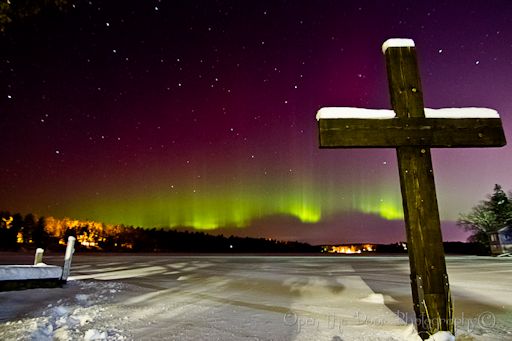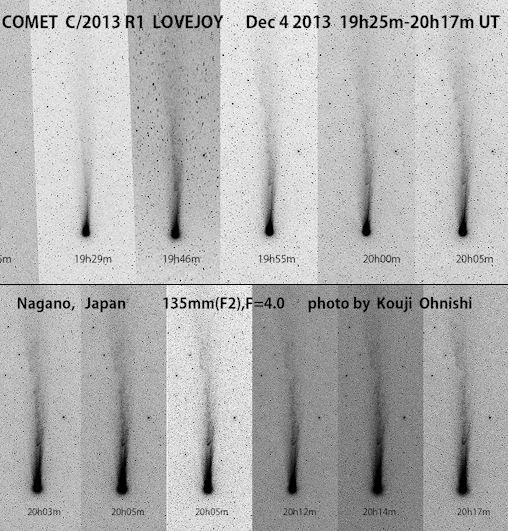GEOMAGNETIC STORM IN PROGRESS: A high-speed solar wind stream is buffeting Earth's magnetic field, sparking G2-class geomagnetic storms around the poles. When Earth first entered the solar wind stream during the late hours of Dec. 7th, Northern Lights spilled over the Canadian border into several US states. Christopher Griffith sends this snapshot from Pillager, Minnesota:
"The auroras were dancing lightly across the sky," says Griffith. "It was quite fantastic and fun to watch despite the temperature being -25 F."
NOAA forecasters estimate a 35% chance of additional geomagnetic storms on Dec. 8th and 9th. High-latitude sky watchers should remain alert for auroras as the solar wind continues to blow. Aurora alerts: text, voice
COMET LOVEJOY'S ACTIVE TAIL: Amateur astronomers around the northern hemisphere are reporting activity in the tail of naked-eye Comet Lovejoy (C/2013 R1). In Nagano, Japan, astrophotographer Kouji Ohnishi could see big changes in less than an hour of monitoring:
Michael Jäger saw the same "disconnection event" from his observatory in Masenberg, Austria, on Dec. 5th. The disturbance could be caused by a gust of solar wind or perhaps an episode of vigorous outgassing in the comet's core.
Comet Lovejoy is now about as bright as a 4th magnitude star. It is visible to the unaided eye from the countryside and is an easy target for backyard telescopes even in urban areas. Monitoring is encouraged. Comet Lovejoy rises in the east just before the morning sun. Sky maps: Dec. 7, 8, 9.

Solar wind
speed: 558.7 km/sec
density: 1.6 protons/cm3
explanation | more data
Updated: Today at 1745 UT
X-ray Solar Flares
6-hr max: C1 1123 UT Dec08
24-hr: C2 1009 UT Dec08
explanation | more data
Updated: Today at: 1700 UT
![]()
Daily Sun: 08 Dec 13
Sunspot AR1916 has a 'beta-gamma' magnetic field that harbors energy for M-class solar flares. Credit: SDO/HMI
![]()
Sunspot number: 104
What is the sunspot number?
Updated 08 Dec 2013
Spotless Days
Current Stretch: 0 days
2013 total: 0 days (0%)
2012 total: 0 days (0%)
2011 total: 2 days (<1%)
2010 total: 51 days (14%)
2009 total: 260 days (71%)
Since 2004: 821 days
Typical Solar Min: 486 days
Update 08 Dec 2013
The Radio Sun
10.7 cm flux: 157 sfu
explanation | more data
Updated 08 Dec 2013
![]()
Current Auroral Oval:
Switch to: Europe, USA, New Zealand, Antarctica
Credit: NOAA/POES
![]()
Planetary K-index
Now: Kp= 2 quiet
24-hr max: Kp= 6 storm
explanation | more data
Interplanetary Mag. Field
Btotal: 6.1 nT
Bz: 0.0 nT
explanation | more data
Updated: Today at 1747 UT
![]()
Coronal Holes: 08 Dec 13
Earth is inside a stream of solar wind flowing from the indicated coronal hole. Credit: SDO/AIA.






